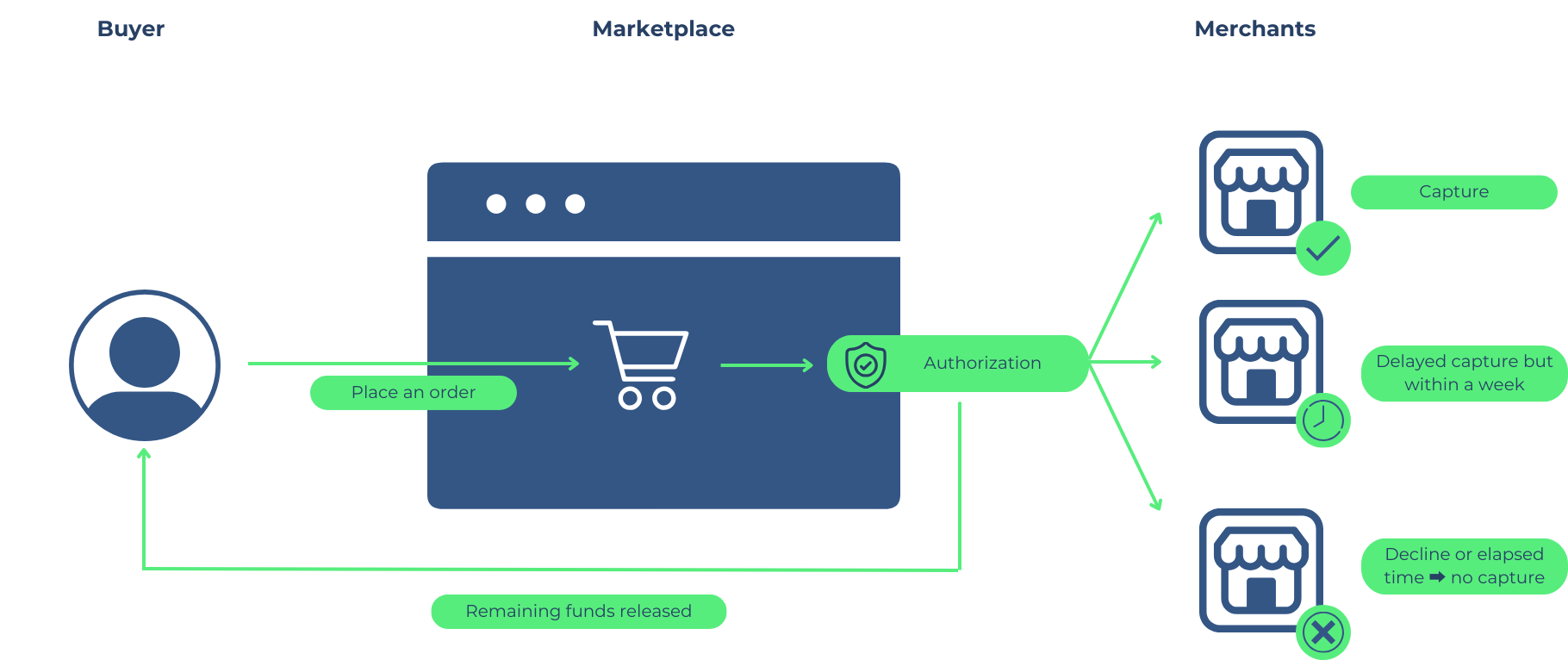Multi-capture Payment
What is multi-capture?
Multi-capture is a payment processing feature that allows a marketplace merchant to charge a buyer's credit card multiple times for a single transaction, over a specified period. Multi-capture lets a merchant make several partial captures of the authorized funds, instead of one single capture.
NoteIf you would like to activate our muliti-capture feature, please contact a memebr of our support team.
Why do some merchants use the multi-capture?
Multi-capture is useful when a merchant needs to split a payment into multiple instalments, or when a product or service is delivered in stages. It is often used by marketplaces to manage and streamline payment processing for multiple sellers or vendors, and to provide a secure and reliable payment experience for customers. Multi-capture has many advantages:
- Reduce Payment Cost
Multi-capture can reduce payment processing costs for every party involved. In addition, it reduces refunds and chargebacks and the associated costs. - Simpler Payment Reconciliation
The payment process is broken down into distinct stages, this makes it easier for the buyers, the marketplace and Lemonway to reconcile payments with specific orders or services. Each capture corresponds to a specific milestone or deliverable, making it straightforward to match payments with the associated products or services provided. - Payment Security
It reduces the risk associated with a single large transaction. By capturing funds in stages, sellers can ensure that they receive payment for each completed phase of a transaction and on the other end, buyers are not charged until the merchants send the order. This minimizes the risk of non-payment or default on the full amount, providing a level of security for sellers. - Reduce Fraud and Chargebacks
If a merchant fails to send the agreed order to the Buyer, then the latter is not changed for the item.
This feature increases buyer experience for multi-vendor basket marketplaces as:
- Only when the customers have their products or services shipped or delivered, the capture is initiated.
- When one of the products or services is not available, the capture is not initiated.
How does multi-capture work?
Example:
John (Merchant 1), Lucas (Merchant 2) and Rita (Merchant 3) are vendors in a marketplace MarketBasket Store online store.
Jane (Buyer) purchases 3 items, one from each merchant, on the MarketBasket Store platform. Jane's shopping cart, with all its contents, is treated as one order, not 3 separate orders.
One authorization, several captures!A marketplace platform can make a final authorization on the total amount of a basket, then capture partial payments as, and if, the transactions are confirmed.
- Initial Authorization (Day 0):
Jane selects 3 items from the 3 different vendors on the marketplace. Her order total is €180 (10 + 120 + 50 =180). Her credit card issuer authorizes the agreed-upon deposit of €180.
| Item | Merchant | Cost per item | Total |
|---|---|---|---|
| Hat | John (Merchant 1) | 10 | €10 |
| Shoes | Lucas (Merchant 2) | 120 | €120 |
| T-Shirt | Rita (Merchant 3) | 50 | €50 |
| ------- | ------ | ------- | €180 |
Once the order has been placed, the marketplace initiates a Transaction (T) for €180 with a final authorization. It reauthorizes the total order amount on the Buyer’s registered card. These funds will be held for seven days.
- First Capture (Day 0):
Vendor 1, John, confirms and ships the item ordered, while the others have not. The Marketplace captures the funds for that item, €10, immediately on the first transaction, creating a new transaction (T1).
The initial Transaction (T) is updated as 10€ have been paid and with a remaining amount at X = 180 - 10 = €170. The transaction still has a status which allows capture.
- Second Capture (Day 3):
Vendor 2, Lucas, confirms and ships the item ordered, while Vendor 3 does not. Only then, the marketplace can capture the funds €120, creating a new Transaction (T2). The initial transaction is updated with a remaining amount at Y = 170 - 120 = €50 and still has a status which allows capture.
- Completion and Final Capture:
- Decline of the order (Day 4)
Vendor 3, Rita, declines the order. The marketplace does not capture the corresponding funds in the pre-authorization. The buyer, Jane, is only billed for the items shipped. Despite the authorization being €180, she is billed €10 + €120 = €130. - Authorization has expired (Day 7)
At D+7, the authorization is expired so the status of the initial transaction (T) is updated and does not allow new capture. The authorization needs to be given again. Until then, The buyer, Jane, is only billed for the items shipped. Despite the authorization of €180, she is billed €10 + €120 = €130. - Final capture (Day 4)
Vendor 3, Rita, confirms and ships the item ordered. The marketplace captures €50, creating a new transaction (T2). The initial transaction is updated with a remaining amount of Z = 50 - 50 = €0. The status changes so that it does not allow capture. By the end of the process, the buyer has paid the full amount for the three items, and the transaction is successfully completed.
- Decline of the order (Day 4)

Multi-capture transaction flows for a multi-vendor operation on a marketplace
By capturing funds incrementally, the multi-capture process mitigates the risk of non-payment or chargebacks, as each party sends or receives payment at each stage of a transaction.
Terms and TimingMulti-capture time and amounts can be customized based on the marketplace's policies and the agreement between the buyer and merchant. However, to issue the completion, captures must be made within 6 days of the initial one.
Updated 11 months ago
